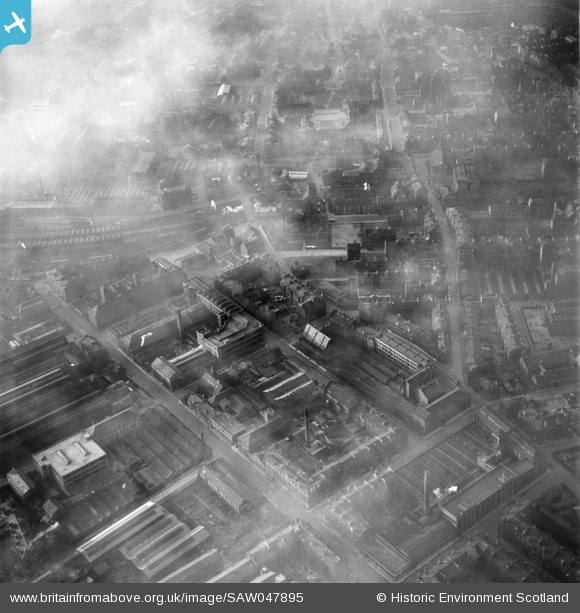© Copyright OpenStreetMap contributors and licensed by the OpenStreetMap Foundation. 2025. Cartography is licensed as CC BY-SA.
Details
| Title |
[SAW047895] Glasgow, general view, showing Broad Street and Millroad Street. An oblique aerial photograph taken facing north-west. |
| Reference |
SAW047895 |
| Date |
1952 |
| Link |
NRHE Collection item 1297839 |
| Place name |
|
| Parish |
GLASGOW (CITY OF GLASGOW) |
| District |
CITY OF GLASGOW |
| Country |
SCOTLAND |
| Easting / Northing |
260870, 664350 |
| Longitude / Latitude |
-4.2227498315276, 55.852274566216 |
| National Grid Reference |
NS609644 |
Pins
 Bloomvale Carpet Works, No 10 Fordneuk Street, Glasgow This factory was founded in 1868 by J & W Lyle, carpet manufacturers. The original works was in Crownpoint Road, and large additions were made in 1872, 1899 and later. By the 1960s the company had also taken over second-hand buildings in adjacent streets. This shows the Fordneuk Street frontage of the main complex. Part of the original building of 1868 is on the right, and at the far end of the frontage an addition of 1872. The linking block was constructed in 1899 to designs by Andrew Myles, architect. Lyles and Templetons were both large-scale carpet manufacturers in the east end of Glasgow until the 1970s, when decline in the demand for traditional woven carpets, and foreign competition, extinguished both. The buildings seen here were demolished in the 1980s. Source: RCAHMS contribution to SCRAN. |

Billy Turner |
Monday 7th of September 2015 08:48:21 PM |
 Hosiery Works, Nos 157-69 Crownpoint Road, Glasgow This works was built for James Ormond, hosier, in 1874. This firm produced knitted undergarments, using for a time a 'Mary Queen of Scots' trademark. This was one of the few 19th-century hosiery concerns in the city. This shows the works from the north-east, illustrating its cramped triangular site. The large number of windows was typical of hosiery works, giving good light for operating the knitting machines. In 1966 the works was being used by Hamilton, Bale & Co Ltd, printers, stationers and drawing office materials makers. It had been demolished by 1988. Source: RCAHMS contribution to SCRAN. |

Billy Turner |
Monday 7th of September 2015 07:58:36 PM |
 Broomward Mill, No 63 Kerr Street, Glasgow This factory was built in about 1867 for Henry Fyfe & Son, power-loom cloth manufacturers, probably to designs by John Gordon, architect. It was one of the last multi-storeyed power-loom weaving factories to be built in Glasgow. This shows the factory from the south-east, with part of the cut-down Broomward Cotton Works of about 1815 on the left. The hand of an architect is evident in the strongly-moulded string-course and cornice, and in the use of both round-headed and flat-headed windows. The mill was used between 1902 and 1967 as a carpet factory, by James Templeton & Co. It has since been demolished. Until the 1960s and 1970s much of the east end of Glasgow was covered with carpet factories, but competition from cheap tufted carpets led to their closure. Source: RCAHMS contribution to SCRAN. |

Billy Turner |
Monday 7th of September 2015 07:35:47 PM |
 St James Primary School, 88 Green Street, Calton |

Billy Turner |
Monday 7th of September 2015 07:04:23 PM |






![[SAW047895] Glasgow, general view, showing Broad Street and Millroad Street. An oblique aerial photograph taken facing north-west.](http://britainfromabove.org.uk/sites/all/libraries/aerofilms-images/public/100x100/SAW/047/SAW047895.jpg)
![[SAW047899] Glasgow, general view, showing Broad Street and East Waterloo Street. An oblique aerial photograph taken facing north-west.](http://britainfromabove.org.uk/sites/all/libraries/aerofilms-images/public/100x100/SAW/047/SAW047899.jpg)
![[SAR008723] Bridgton Glasgow, Lanarkshire, Scotland. An oblique aerial photograph taken facing North.](http://britainfromabove.org.uk/sites/all/libraries/aerofilms-images/public/100x100/SAR/008/SAR008723.jpg)
![[SAR008787] Bridgton, Glasgow Glasgow, Lanarkshire, Scotland. An oblique aerial photograph taken facing East.](http://britainfromabove.org.uk/sites/all/libraries/aerofilms-images/public/100x100/SAR/008/SAR008787.jpg)
![[SPW035722] Glasgow, general view, showing Mavor and Coulson Engineering Works, Broad Street and Orr Street. An oblique aerial photograph taken facing north.](http://britainfromabove.org.uk/sites/all/libraries/aerofilms-images/public/100x100/SPW/035/SPW035722.jpg)
![[SPW035723] Glasgow, general view, showing Mavor and Coulson Engineering Works, Broad Street and Brook Street. An oblique aerial photograph taken facing north-west.](http://britainfromabove.org.uk/sites/all/libraries/aerofilms-images/public/100x100/SPW/035/SPW035723.jpg)
![[SPW035724] Mavor and Coulson Engineering Works, Broad Street, Glasgow. An oblique aerial photograph taken facing north.](http://britainfromabove.org.uk/sites/all/libraries/aerofilms-images/public/100x100/SPW/035/SPW035724.jpg)
![[SPW035725] Glasgow, general view, showing Mavor and Coulson Engineering Works, Broad Street and Redan Street. An oblique aerial photograph taken facing north.](http://britainfromabove.org.uk/sites/all/libraries/aerofilms-images/public/100x100/SPW/035/SPW035725.jpg)
![[SPW035726] Mavor and Coulson Engineering Works, Broad Street, Glasgow. An oblique aerial photograph taken facing north.](http://britainfromabove.org.uk/sites/all/libraries/aerofilms-images/public/100x100/SPW/035/SPW035726.jpg)
![[SPW035727] Mavor and Coulson Engineering Works, Broad Street, Glasgow. An oblique aerial photograph taken facing north.](http://britainfromabove.org.uk/sites/all/libraries/aerofilms-images/public/100x100/SPW/035/SPW035727.jpg)
![[SPW035728] Mavor and Coulson Engineering Works, Broad Street, Glasgow. An oblique aerial photograph taken facing south.](http://britainfromabove.org.uk/sites/all/libraries/aerofilms-images/public/100x100/SPW/035/SPW035728.jpg)
![[SAW047896] Glasgow, general view, showing Crownpoint Road and London Road. An oblique aerial photograph taken facing south-east.](http://britainfromabove.org.uk/sites/all/libraries/aerofilms-images/public/100x100/SAW/047/SAW047896.jpg)
![[SAW048024] L.Lyle and Son, Bridgeton, Glasgow, Lanarkshire, Scotland, 1952. An oblique aerial photograph taken facing South .](http://britainfromabove.org.uk/sites/all/libraries/aerofilms-images/public/100x100/SAW/048/SAW048024.jpg)



